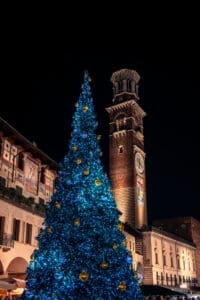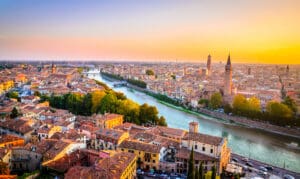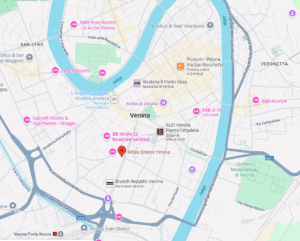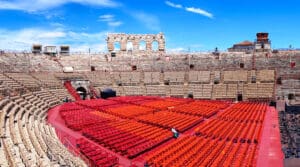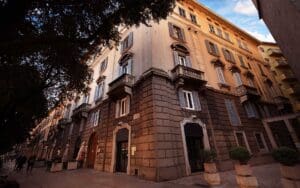Discover typical Veronese dishes, from starters to desserts, and the best tips on where to enjoy local cuisine in the city of love.
Verona is a city not only rich in history and culture, but also in a culinary tradition fascinating. This article will explore the typical dishes that characterize Veronese cuisine, offering a comprehensive guide on what to taste during your visit to this charming city.
The excellence of risotto with Amarone
Amarone Risotto is a dish that embodies the excellence of Veronese cuisine, with deep roots in the gastronomic tradition of the region. This risotto is not just a simple dish, but a true work of culinary art that amazes and satisfies every palate. Its preparation requires respect for high-quality ingredients and attention to detail, elements that enhance its flavor and texture. The unique combination of the Vialone Nano rice and Amarone della Valpolicella. creates a dish that is not only nutritious but also a sensory experience.
Vialone Nano rice, recognized for its ability to absorb flavors without losing its shape, is the main ingredient in this risotto. Originating in the wetlands of the Basso Veronese area, this rice is prized for its creaminess and al dente texture. The Vialone Nano variety has received IGP recognition, ensuring that the characteristics and quality are maintained in each grain. This rice is expertly paired with Amarone, a high-quality red wine known for its intense bouquet and hints of dried red fruits and spices. Amarone is made using dried grapes, a traditional technique that concentrates flavors and produces a wine of great complexity. This richness gives the risotto an enveloping and deep flavor, making it an iconic dish of Veronese food and wine.
La preparation of risotto with Amarone is a process that requires patience and care. It begins by sautéing shallots and garlic in olive oil, creating a perfect aromatic base. Next, you add the rice, which must be roasted for a few minutes until the grains are shiny and transparent. This step is crucial to ensure that the rice fully absorbs the flavors of the Amarone. After blending the rice with the wine, proceed by adding hot stock and water a little at a time, stirring constantly. The constant stirring promotes the release of starch from the rice, helping to create that characteristic creaminess of the risotto. Finally, to further enrich the dish, butter and Parmigiano Reggiano cheese are incorporated, for a lush and satisfying end result.
Risotto all'Amarone is also emblematic of Verona's gastronomic tradition, representing a deep connection with the territory. This dish is often served on special occasions and during festive meals, becoming the star of elegant dinners and family celebrations. It is the ideal choice to accompany typical Veronese products, such as Monte Veronese DOP, a local cheese that goes perfectly with the intense flavor of risotto. Its versatility makes it suitable for multiple pairings, both with meat and vegetarian dishes, making every meal a rewarding experience.
Every year during the winter months, risotto all'Amarone conquers the hearts and palates of visitors and locals alike, making its way onto the menus of restaurants and trattorias. In some of Verona's best locations, restaurateurs offer unique versions of the dish, enriching it with ingredients such as porcini mushrooms or guanciale, which enhance its flavor. For those visiting Verona, it is almost a must to savor this dish in the most renowned restaurants, where tradition meets culinary innovation.
Restaurants such as "Antica Bottega Vini" and "Al Bersagliere" are known for their high-quality versions of risotto all'Amarone, offering a welcoming atmosphere and impeccable service. The chefs' passion for local gastronomy is reflected in every course, making the dining experience in Verona unforgettable. L'Amarone is not just a wine to pair with risotto, but an integral part of the region's culture and gastronomic heritage. Each sip of Amarone enjoyed with this risotto creates a harmonious relationship between food and wine, an experience that celebrates the authentic flavors and culinary traditions of Verona.
In conclusion, the risotto with Amarone is much more than a dish; it is a a symbol of Verona's culinary culture, a gastronomic experience that calls to mind the warmth of family traditions and the richness of the territory. Ideal for romantic dinners, Sunday lunches or simple festive occasions, it represents the beating heart of Veronese cuisine, capable of winning everyone over with its creaminess, intense flavor and enveloping aroma. There is no better way to get to know Verona than through the palate, and risotto all'Amarone is the perfect dish to start this unforgettable gastronomic journey.
The classic potato gnocchi
The potato dumplings represent one of the fundamental delights of Verona cuisine, a dish that evokes memories of celebration, conviviality and love of tradition. These soft pieces of dough, normally served as a first course, are not only a food, but a symbol of affection and togetherness, particularly during the Verona Carnival. Indeed, in the context of the region's historicity and culinary traditions, potato gnocchi are deeply linked to the celebration of "Friday gnocolar," which marks the culmination of Carnival.
The tradition of potato gnocchi in Verona dates back five centuries, to 1531 to be precise, when a severe famine forced local authorities to scatter food among the population during carnival. It is said that the nobleman Tommaso Da Vico, in particular, left a bequest in his will so that every year, on the Friday before Lent, food would be distributed to the inhabitants of the neighborhood of San Zeno. This charitable gesture marked the beginning of the Friday gnocolar tradition, which today is celebrated with an extraordinary parade that attracts visitors and residents.
As for the preparation, the potato dumplings require simple but selected ingredients. The main ones are: potatoes, flour, eggs and salt. The process involves boiling the potatoes, which must be of a floury variety, mashing them and mixing them with flour and an egg until a soft dough is obtained. Once cylinders of dough have been formed, they are cut into small pieces and knocked over the tines of a fork or passed through a spinning wheel to give them their typical shape.
One fascinating aspect of gnocchi is the variety of sauces and toppings with which they can be served, making each dish unique and personal. The most traditional toppings include a simple tomato sauce with Grana Padano grated, butter fused and sage, or even a rich meat sauce. A Veronese specialty that deserves a mention is "pastissada de caval," a stew of horse meat cooked long until tender, which can accompany gnocchi beautifully.
The historical importance of these dumplings goes beyond just the list of ingredients or cooking methods; they embody a tradition which celebrates community, family and culinary traditions. During the Carnival, dumplings are prepared and shared in large quantities, uniting us in an act of generosity and playful participation in the celebration. The Friday gnocolar is not only a day of culinary delights, but an opportunity to relive the connection with Veronese history and culture, uniting old and new generations in one gastronomic celebration.
In this context, it is useful to note that there are regional variations of gnocchi even outside Verona, such as the "canederli" of Trentino, made from stale bread, or the "gnocchi alla romana," made with semolina instead of potatoes. However, Verona's potato gnocchi remain unmatched for their goodness and their ability to convey a sense of home and belonging.
In summary, the potato dumplings are not just a dish to be enjoyed, but a real culinary monument of Veronese tradition, capable of recalling moments of celebration and conviviality that unite the community around a table. Whether it is a family dinner or a grand celebration during Carnival, potato gnocchi are destined to remain in the hearts and tables of the people of Verona for generations to come.
Salad with boiled meat and pearà
L'salad with boiled meat and pearà is a delicious traditional dish that represents the essence of Veronese cuisine, a true symbol of conviviality and hospitality for the local community. This dish consists mainly of boiled meat and the famous pearà, an intensely flavored sauce made from breadcrumbs, ox marrow, and black pepper. The preparation is passed down from generation to generation, especially during holidays and Sunday lunches, creating a deep connection with the history and culture of the city.
Lesso has very ancient historical origins, used by Veronese families to prepare a hearty and nutritious meal. The technique for cooking lesso involves cooking meat and vegetables in cold water, along with onions, carrots, and celery, to make a rich and flavorful broth. Unlike boiling, in which the meat is immersed in water that is already boiling, lesso allows all the flavor to be extracted from the meat, creating a dish with an enveloping flavor. Usually, different types of meat are used, such as beef, beef tongue, and chicken, but cotechino is an important addition, especially popular during the holiday season.
La pearà, on the other hand, is a sauce which is distinguished by its characteristic spiciness. Its preparation is a ritual in itself, in which ox marrow is slowly melted, along with a generous amount of black pepper and butter. Breadcrumbs are added, which absorbs the flavors of the marrow and broth, making the sauce creamy and thick. This dish requires time and patience, as the pearà must simmer over low heat to allow the flavors to meld and intensify. According to tradition, the longer you cook the pearà, the better the end result will be. Once ready, it is served hot, accompanying the boiled meat in an embrace of flavors.
The cultural importance of salad with lesso and pearà in Verona is undeniable. It is not just a dish to be enjoyed; it represents a moment of conviviality, an association that unites families around the table. During cold winter Sundays, this dish is a symbol of warmth and welcome, essential for family gatherings. Each family has its own secret recipe and method of preparation, enriching the dish with personal variations involving the choice of meat or the addition of spices. This makes each serving of lesso e pearà an authentic expression of Veronese culinary identity.
In terms of presentation, salad with boiled meat and pearà is simple but enveloping. It is usually served on a large serving platter, with the slices of meat carefully arranged and generous spoonfuls of pearà poured on top. This generosity reflects the spirit of sharing that characterizes Verona cuisine. The different meats, lightly reheated, are arranged harmoniously, accompanied by portions of pearà, creating a play of colors and textures that invites to be enjoyed.
Currently, salad with lesso and pearà is not only a traditional dish but has also found its place in Verona's gourmet restaurants, where chefs reinterpret the classic recipe, keeping the flavors intact while innovating in methods of preparation and presentation. However, its essence remains the same, anchored in the historical and cultural roots of the city.
For the people of Verona, salad with lesso and pearà is not just a meal; it is a way to relive tradition, to honor the memory of those who prepared this dish before them, and to pass this legacy on to others in turn. The ritual of preparation, the choice of fresh, local ingredients, and the attention to detail are all elements that give this dish its uniqueness and cultural contribution.
In conclusion, thesalad with boiled meat and pearà Is more than just a dish. It is a celebration of veronese cuisine, of its traditions and the sense of community that pervades every table. In every bite, you can feel the warmth, history and passion of a cuisine that has stood the test of time, always remaining a mainstay of Verona's gastronomy.
Typical Veronese sweets: the Pandoro
The **Pandoro** is undoubtedly one of Verona's most emblematic desserts, particularly during the Christmas holidays. Originally known as "Pan de Oro" (golden bread), Pandoro has a fascinating history that is intertwined with the culinary traditions of the city and region of Veneto. Its origin dates back to the 13th century, with an assumption that the cake evolved from an ancient recipe known as "Nadalin". La Pandoro tradition as a Christmas dessert has its roots in the aristocratic past of Verona and Venice, where nobles served it during celebrations.
La typical star shape of Pandoro, with its eight cloves, is one of the most characteristic aspects of this cake. La preparation is an artistic experience in itself; the dough is composed of simple, high-quality ingredients, such as flour, sugar, eggs, butter and yeast. The art of leavening is crucial: the Pandoro must be kneaded for a long time and let the dough rise until it has a light and fluffy texture. This process is what gives Pandoro its unique, almost cloudy texture that melts in the mouth.
During the holiday season, Pandoro is not only a dessert, but a symbol of sharing and celebration. It is traditionally served dusted with powdered sugar and accompanied by a mascarpone cream, which enhances its taste and softness. The cream, prepared with mascarpone and sugar, often enriched with a pinch of vanilla or a dash of liqueur such as Vin Santo, creates a perfect combination that amazes every palate. It is not uncommon to find fancier variants of Pandoro, such as those filled with Nutella or covered in chocolate, but the traditional recipe remains the heart of Verona's celebrations.
In Verona, the historic bakeries, such as **Flego**, are famous for their artisanal versions of Pandoro. These places are a treasure trove for the sweet tooth, offering sweets made according to old family recipes. A visit to one of these pastry shops is not only an opportunity to enjoy Pandoro, but also to get in touch with the culture and traditions of Verona.
Pandoro is more than just a dessert; it is a tradition that brings families and friends together around the table, evoking memories, stories and emotional ties. The holidays, with their festive lights and decorations, frame this culinary experience. The cake also lends itself to moments of conviviality, such as Christmas dinners, where it is served as a symbol of sweetness, love and unity.
The preparation of Pandoro is not without its difficulties. It is essential to respect leavening times and to adopt proper techniques to achieve the right lightness. Each master pastry chef has his own secrets, handed down from generation to generation, to achieve the fluffiness that makes Pandoro so special.
Different variations of Pandoro are catching on, such as Pandoro flavored with spices or even vegan recipes that try to maintain the traditional softness, but there is no doubt that the classic Pandoro remains the undisputed king of the table during the holidays.
But beyond taste and preparation, the Pandoro represents a cultural link for Verona. Every bite is a celebration of the history of this city, its people and its traditions. Patisseries are not only places to buy sweets, but they are also spaces where stories are passed down and experiences are shared.
In short, Pandoro di Verona is not only a Christmas dessert, but a symbol of sharing and tradition. It encapsulates the essence of an entire gastronomic culture, inviting anyone who tastes it to take a journey linked to the history, flavors and aromas of this magnificent city. Thus, during the holidays, every bite of Pandoro becomes a sweet memory of love and conviviality, to be enjoyed and shared.
Conclusions
La Verona cuisine is a reflection of his rich history and culture, with dishes that tell stories of tradition and unique flavors. Taste the risotto with Amarone, the potato gnocchi, the boiled meat with pearà and the Pandoro allows you to immerse yourself in the true essence of the city. Don't miss the opportunity to explore these delights during your visit to Verona.

